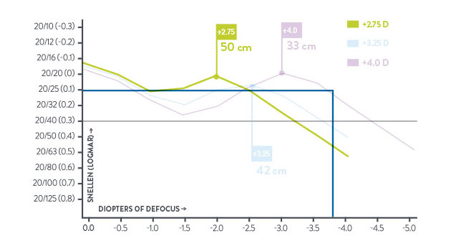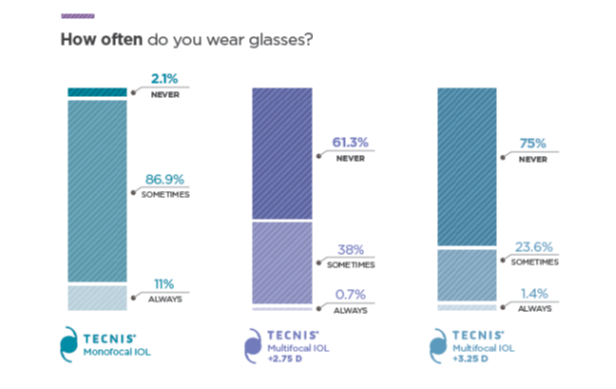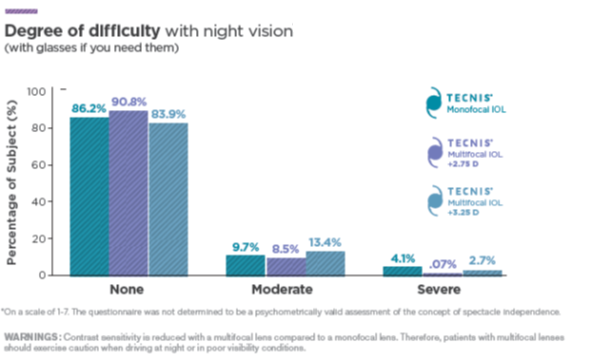TECNISTM Multifocal IOL +2.75 D
TECNISTM Multifocal IOL +2.75 D
To order this product, please contact your sales rep.
Instructional Guides
Instructional Guides
Instructional Guides
Outstanding, Full-Range Vision Tailored for Intermediate Distances
No two patients are exactly alike, which is why we offer multifocal lens options optimized for varying visual demands. The TECNISTM Multifocal IOL +2.75 D delivers a full range of sharp vision tailored for intermediate distances.1

The TECNISTM Multifocal IOL +2.75 D is designed with your patients in mind. Optimized for those favoring intermediate vision activities like grocery shopping, it delivers tailored clarity at a theoretical reading distance of 50 cm.2
Binocular Defocus Curve at 6 Months3-5

Distances (cm) in the graph are approximate. +4.0D data are historical from a separate clinical study using the same test methodology.
The TECNISTM Multifocal Family of 1-Piece IOLs features the only multifocal lenses capable of providing a full range of high-quality vision (20/25 or better),3-5 tailored for each patient’s lifestyle.
- Sharp vision across near, intermediate and distance vision3-5
- Optimized for a theoretical reading distance of 50 cm with the +2.75 D lens2
Give your patients a lens designed for real-world performance. The TECNISTM Multifocal IOL +2.75 D delivers tailored increased spectacle independence in low-light performance for outstanding outcomes, even at night.1-3
How Often Do You Wear Glasses?*5

Degree of Difficulty** With Night Vision*5

Give your patients outstanding low-light performance:
- 90.8% of patients experienced no difficulty with night vision***5
- 76.8% of patients experienced no difficulty with glare***5
- 69.0% of patients experienced no difficulty with halos***5
Unlike another leading IOL, TECNISTM IOL material is not associated
with glistenings,6-10 which can inhibit your patients’ vision. Glistenings
cause light scatter, which can result in a reduction in image contrast.7-11
97% of patients would elect to have the TECNISTM Multifocal IOL +2.75 D again.*5
|
Model: |
ZKB00 |
|
|
OPTIC CHARACTERISTICS1 |
||
|
Powers: |
+5.0 D to 34.0 D in 0.5 diopter increments |
|
|
Diameter: |
6.0 mm |
|
|
Shape: |
Biconvex, anterior aspheric surface, posterior diffractive surface |
|
|
Add Power (IOL Plane): |
+2.75 D |
|
|
Add Power (Spec Plane): |
+2.01 D |
|
|
Material: |
UV-absorbing hydrophobic acrylic |
|
|
Refractive Index: |
1.47 at 35˚ C |
|
|
Chromatic Aberration (Abbe Number): |
55 |
|
|
Edge Design: |
ProTEC frosted, continuous 360˚ posterior square edge |
|
|
BIOMETRY |
CONTACT ULTRASOUND |
OPTICAL |
|
A-Constant: |
118.8† |
119.3‡ |
|
Theoretical AC Depth: |
5.40 mm |
5.72 mm |
|
Surgeon Factor:12 |
1.68 mm |
1.96 mm |
|
HAPTIC CHARACTERISTICS1 |
||
|
Overall Diameter: |
13.0 mm |
|
|
Style: |
C |
|
|
Material: |
UV-absorbing hydrophobic acrylic |
|
|
Design: |
Haptics offset from optic |
|
IOL INSERTION
Recommended insertion instruments:
- UNFOLDERTM Platinum 1 Series Delivery System: Intuitive push-and-twist, screw-style insertion designed to simplify lens implantation.
FOOTNOTES
*The questionnaire was not determined to be a psychometrically valid assessment of the concept of spectacle independence.
**On a scale of 1-7, with glasses as needed
†Value theoretically derived for a typical 20.00 D lens. Johnson & Johnson Vision recommends that surgeons personalize their A-constant based on their surgical techniques and equipment, experience with the lens model and postoperative results.
‡Derived from clinical evaluation results of the TECNISTM 1-Piece IOL Platform.
REFERENCES
1. TECNISTM MF 1-Piece IOL, Model ZKB00 - DfU INT - Z311276, Rev. 02, June 2019. REF2020CT4237.
2. FDA - The TECNISTM Multifocal 1-Piece IOLs, Models ZKB00, ZLB00 and ZMB00, Patient Information Brochure. REF2015CT0285.
3. SSED TECNISTM MF ZM900-ZMA00, P0800010, Jan 16,2009. REF2015OTH0648.
4. Data on File - Terwee T. Optical Performance of the TECNISTM Multifocal IOLs ZMA00 and ZMB00 measured in-vitro in an eye model in green and white light, in comparison with the competitor MF IOLs AcrySOF ReSTOR SN5AD1 (Alcon), Acri.Lisa 356D (Zeiss) and CrystaLens HD500 (Bausch & Lomb). Sep. 8, 2009. REF2014CT0046.
5. SSED TECNISTM MF ZKB00 - ZLB00, P980040/S049. Dec. 17, 2014. REF2015OTH0646.
6. 150 - Data on File – Sensar not associated with glistenings – Literature analysis. 2013. REF2014OTH0002.
7. Nagata M, et al. Clinical evaluation of the transparency of hydrophobic acrylic intraocular lens optics. J Cataract Refract Surg. 2010;36(12):2056-2060. REF2015CT0080
8. Christiansen G, et al. Glistenings in the AcrySof® intraocular lens: Pilot study. J Cataract Refract Surg. 2001;27(5):728-733. REF2014MLT0005.
9. Colin J, et al. Incidence of glistenings with the latest generation of yellow-tinted hydrophobic acrylic intraocular lenses. J Cataract Refract Surg. 2012;38(7):1140-1146. REF2014MLT0006.
10. Gunenc U, et al. Effects on visual function of glistenings and folding marks in AcrySof® intraocular lenses. J Cataract Refract Surg. 2001;27(10):1611-1614. REF2014MLT0011.
11. Van der Mooren M, Franssen L, Piers P. Effects of glistenings in intraocular lenses. Biomed Opt Express. 2013;4(8):1294-1304. REF2014OTH0139.
12. Calculated based on Holladay I formula: Holladay JT, Prager TC, Chandler TY, Musgrove KH, Lewis JW, Ruis RS. A three-part system for refining intraocular lens power calculations. J Cataract Refract Surg. 1988;14(1)17-24. REF2014CT0092.
© Johnson & Johnson Surgical Vision, Inc. 2022.
For healthcare professionals only. Please reference the Instructions for Use for a complete list of Indications and Important Safety Information and contact our specialists in case of any question
PP2022MLT4205

